
Science fiction and technology writer
Popular blog posts
Recent forum posts
Discussion Forum
Discussion forumShowing topics tagged as: Science
I’m writing a visual novel!
Post #: 232
Post type: Blog post
Date: 2014-12-09 09:13:12.000
Author: Jeremy Reimer
Tags: Writing, Science Fiction, Gaming
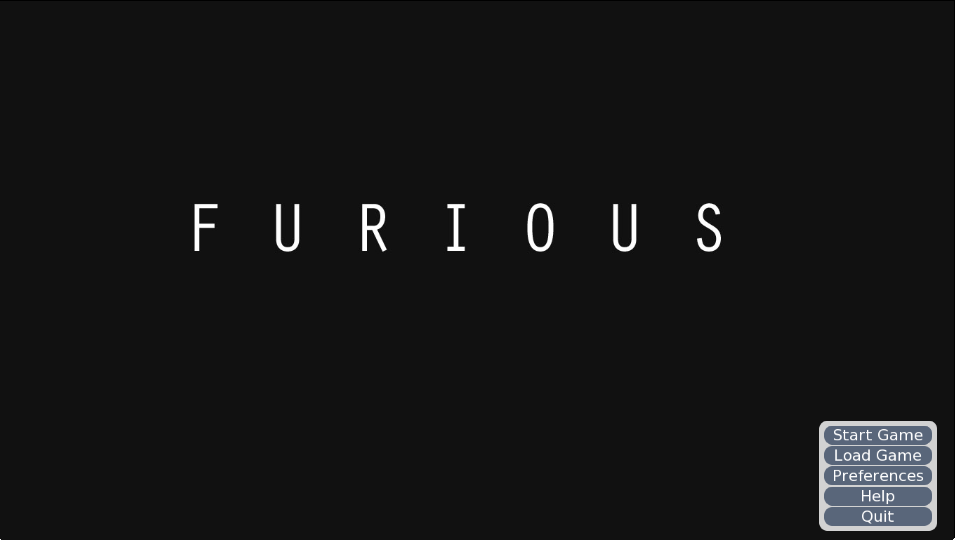
After playing Christine Love’s amazing games Digital: A Love Story and Analogue: A Hate Story (which I reviewed here) I became obsessed with the possibilities of visual novels. They reminded me a bit of the Choose Your Own Adventure books that I adored as a child, but with many new possibilities and experiences that those books couldn’t offer.
I also loved them because they combined my two great loves: writing and gaming. Unlike with most games, where the story served as mere window dressing, visual novels put the writing front and center. So as I was casting about wondering what to write next after completing my science fiction novel trilogy, it struck me: why not make a visual novel myself?
The idea seized hold of me and wouldn’t let go. Unlike the effort required to make a full game (or even an extensive game mod), creating a short visual novel seemed like it was within my grasp. Usually these games are made with a writer and an artist collaborating together, but I love dabbling in basic 3D rendering and 2D drawn art, so why not do both? In fact, the first idea I had for a visual novel was a story I called "I only want to do everything", based on an AI that slowly learns how to live in a virtual world of its own creation. That idea turned out to be too open-ended and complex for my first visual novel, but I might return to it at a later date.
The story I ended up deciding on is a prequel to my trilogy of sci-fi novels. It is set on the Jaguar-class light carrier Furious during the first Earth-Zruthy war. This war is mentioned in Edge of Infinity by the protagonist Jack Davidson, whose parents were killed during that conflict. I never got a chance to delve more deeply into the war before now. Why were the Earth forces and the Zruthy fighting? What was the war like? How did it end? This visual novel gives me a chance to answer these questions.
The player portrays the fighter commander of the Furious, who was injured in combat and slowly recovering his or her memories. The player must talk to six different pilots on the ship, all of whom have very different personalities, likes and dislikes, and interests (I asked my wife, who is very interested in Myers-Brigg personality types, to help me with the character creation). By talking with the pilots before and after they fly out on missions, the player can subtly influence how they will perform under pressure. This will become more and more important as the missions get increasingly dangerous.
I’m having a blast creating the game in the Ren’Py visual novel engine, which is written in Python. Creating a visual novel is just the right combination of art, programming, and writing. I have no idea how long it will take to complete, but I’m estimating about six months right now. I can’t wait to finish it and show it to the world!
Views: 7083
Book Review - William Gibson’s The Peripheral
Post #: 231
Post type: Blog post
Date: 2014-12-03 09:47:05.000
Author: Jeremy Reimer
Tags: Science Fiction
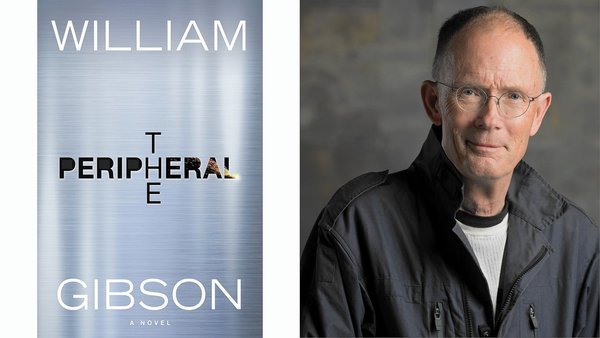
It’s hard to believe that William Gibson’s seminal book Neuromancer was first printed thirty years ago in 1984. Neuromancer gave the world the term "cyberspace" and created an entirely new genre of fiction known as cyberpunk. I remember reading this book as a young boy and being utterly entranced by this vision of the future that was so new and yet so utterly believable.
Neuromancer was a bestseller and its overwhelming success painted Gibson into a bit of a corner. After finishing two sequels, he felt he wanted to explore the more immediate future instead. In the mean time, the world was catching up to Gibson’s original vision. At some point the two converged, and Gibson wound up writing very interesting novels about the present while the world raced on to an uncertain future. On one hand, it was fascinating to note that we largely live in the world of Neuromancer (in broad strokes if not in actual details) but on the other hand I missed having Gibson’s view of what was to come.
With the release of The Peripheral, Gibson has jumped strongly back into speculative fiction, and the result is spectacular. As if to make up for lost time, The Peripheral includes not one but two futures, one set in the 2030s and the other about half a century later. A group of people in the far future manage to find a way to communicate digitally with the near future, and through advanced "peripheral" technology (essentially a biological avatar) they manage to bring people from the past to their present.
I almost didn’t want to write that much in this review, because knowing too much spoils some of the fun of reading it. I had deliberately avoided all reviews before buying my copy, so I went into it completely unprepared. Gibson doles out information in tiny morsels as the story goes along, which gives the reader a delightful sense of slowly coming to an understanding of both worlds. Initially, I wasn’t even certain that there were two realities, but I did feel like one set of characters were living in a world not too far from our own, whereas the others were living in some crazy world that made no sense at all. I loved piecing all the clues together at about the same rate as the characters were doing.
Speaking of the characters, the young heroine Flynn Fisher is one of Gibson’s most well-realized and relatable protagonists. While she is caught up in a whirlwind of shifting forces that she has little control over, she also manages to take initiative and make her own choices. The protagonist in the far future, Wilf Netherton, is a wonderful bundle of contradictions who accepts that his role as a Public Relations agent is really to be a professional liar.
The story itself, like the best science fiction, is a cautionary tale for our current society. It shows us two worlds that could very well arise from our own, and the inhabitants of both worlds long for things to be different than they are. The Peripheral is Gibson’s finest writing to date, and I can’t wait to read it again.
Views: 8537
Beyond the Expanse
Post #: 226
Post type: Blog post
Date: 2014-09-01 10:25:10.000
Author: Jeremy Reimer
Tags: My Science Fiction
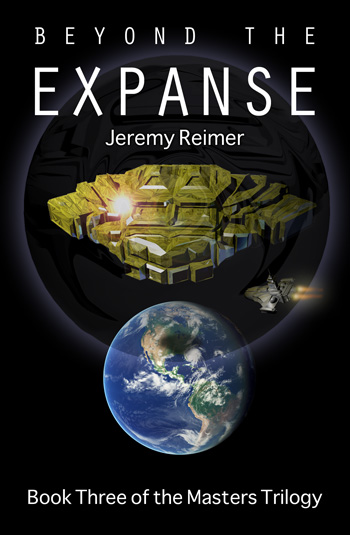
Over twelve years ago I had a dream. I had all these ideas bubbling up inside of me from a lifetime of reading and watching science fiction, and I wanted to make them come alive in some form. I dreamed of writing an epic trilogy that would follow the adventures of heroic space pilots fighting an evil alien enemy.
Today, at long last, that dream has been fulfilled.
Beyond the Expanse is the final installment of the Masters trilogy. It is now available on Lulu.
While the novels are, at their heart, fun and escapist sci-fi entertainment, there are deeper themes than simply the good guys winning over the bad guys. The characters struggle against their own fears and weaknesses, and they take time to think about the ramifications of their actions. The enemy aliens (while definitely evil!) have problems of their own, and some of them rail helplessly against what their once-proud society has become.
Ultimately, the trilogy is about the triumph of hope over fear. It is about how very different people can overcome their mutual mistrust and learn to work together for the betterment of everyone. And it is about how even the smallest people can make a real difference in the universe, simply from the choices that they make.
I hope you enjoy the book.
Views: 6188
The Last Bonjwa - My love letter to Starcraft
Post #: 221
Post type: Blog post
Date: 2013-12-27 09:11:30.000
Author: Jeremy Reimer
Tags: Writing, Science Fiction
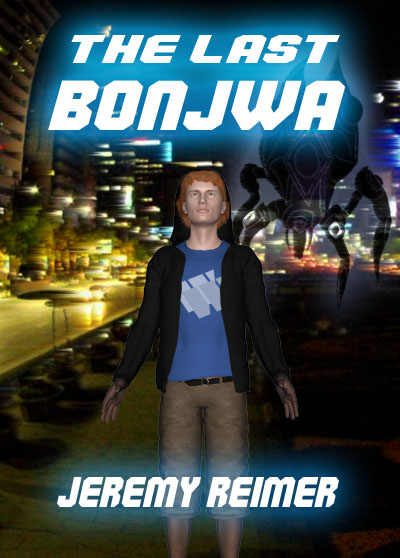
I’ve watched hundreds of hours of professional Starcraft matches. I have my favorite players and teams who I cheered for when they won and cried when they lost. I’ve immersed myself in the unique and wonderful world of professional gaming, of this tiny (but growing) subculture called eSports.
Today, I’m releasing my love letter to the game and the scene itself. It’s a full-length novel titled The Last Bonjwa.
The Last Bonjwa follows the adventures of John "Heart" Wolanski, a professional Starcraft player living in Korea. It’s a few years in the future in an alternate timeline, so the names of players and teams are different, but fans of the scene will recognize many similarities to our own universe.
John is nearing the twilight of his career, and the popularity of the game itself is waning, but he refuses to go down without a fight. But when he receives a threatening email, he is suddenly thrown into a world he knows nothing about, as he must fight shadowy forces who are out to kill him, all while trying to qualify for the biggest tournament of his life.
The Last Bonjwa is a fast-paced action adventure, but it’s also a peek into the fascinating world of eSports seen through the eyes of a player. It is a sequel to my short story "The Stalker", in which John encountered an artificial intelligence inside the game itself.
The Last Bonjwa is now available on Smashwords in a variety of eBook formats for all viewers, all DRM-free, for $2.99. No knowledge of the game is required to enjoy the story, but familiarity with it will make the tale seem even richer.
Views: 7283
I’m doing NaNoWriMo!
Post #: 217
Post type: Blog post
Date: 2013-11-04 15:39:06.000
Author: Jeremy Reimer
Tags: Writing, Science Fiction

After finishing my third novel in my trilogy (it’s still in editing) and starting the planning for a series of short stories, I wasn’t sure if National Novel Writing Month was a good idea. I had lots of projects on the go, and what could I possibly do in a month?
Then I remembered my short story The Stalker, which came out of my love for professional Starcraft. It had a lot of downloads in October, and for the first time even beat out my science fiction short story Starfarer. I had always told myself that if The Stalker did well enough I would make a full-length novel out of it.
Well, this was my chance!
The novel is called The Last Bonjwa and after three days, I’ve written 5,000 words, on pace for the goal of 50,000 by the end of November. I’m already really excited about this story because the faster pace of writing is showing up in the text itself. In just those first 5k words, our hero has won a tournament, gotten blackmailed, lost his best friend, got kidnapped, been interrogated by shady government people, had his apartment broken into, and was chased off a train by a tall stranger in a dark overcoat.
I have no idea how I’m going to tie everything together but I’m having a blast trying. The novel is also kind of a love letter to the professional Starcraft scene and Korea itself.
Look for it in time for the holidays along with Beyond the Expanse!
EDIT: A WINNER IS ME
Views: 6654
Fun at the SIWC Book Fair
Post #: 216
Post type: Blog post
Date: 2013-10-29 10:37:01.000
Author: Jeremy Reimer
Tags: Writing, Science Fiction
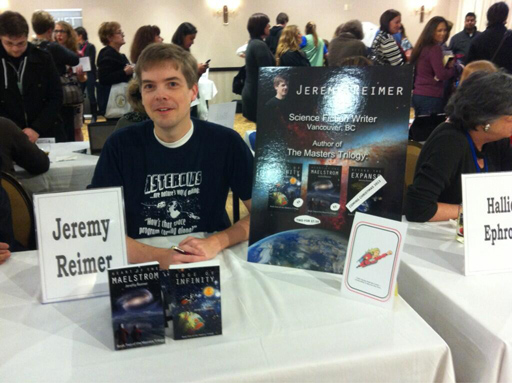
I had an amazing time at the Book Fair last Saturday. It was a brand new experience for me and I couldn’t have asked for more.
The Book Fair is an interesting event. Independent authors are mixed in with established traditional authors, so there was plenty of opportunity to meet people on the other side of the publishing equation. I shared a table with Don "DD" DeBrandt, a long-time science fiction and fantasy author who is working on his twenty-sixth novel! Don was a great companion and had lots of stories about his writing career. He was impressed with my poster and bet me a nickel that someone would ask for one of my autographed books before they asked for one of his. Hey, Don, you still owe me that nickel!
I did sell a couple of copies of my book, but that wasn’t the main purpose of attending the event. It was mostly to get some experience and meet interesting people, and show my name as a local author. In all of these aspects it was a great success. People really did like my poster and asked me how I made it and how much it cost (Photoshop, and $40 at Kinko’s). I got to talk about science fiction and future technology with other writers and fans, which was amazing.
I’m definitely going next year!
Views: 6515
I will be booksigning at the Surrey International Writing Festival, Saturday, Oct 26, 5:30 to 7:00 pm!
Post #: 215
Post type: Blog post
Date: 2013-10-24 13:37:35.000
Author: Jeremy Reimer
Tags: Writing, Science Fiction

This Saturday I’ll be at the Book Fair in the Surrey International Writer’s Festival! The event is at the Sheraton Vancouver Guildford Hotel, 15269 104 Ave, in Surrey, BC. The event runs from 5:30 to 7:00 pm.
I’m humbled to be included with so many amazing writers, and I’m really looking forward to the experience. It’s my first ever book signing, so please come out and say hello!
Views: 7409
Creating the cover for Beyond the Expanse
Post #: 214
Post type: Blog post
Date: 2013-10-01 15:41:55.000
Author: Jeremy Reimer
Tags: Science Fiction, Writing
I’ve always loved science fiction covers, and even have my own favorite artists, but the cover images for science fiction classics often have little to do with the actual story. One of the great things about being an independent author is the ability to make your own covers. Each cover for my three novels represents a seminal moment in the story.
For the final novel, Beyond the Expanse, I wanted to show a dramatic moment with the Pegasus confronting a Master worldship in front of the planet Earth. First, I drew a quick sketch to get a sense of the layout I wanted. Lots of erasing and moving stuff around, so it looks messy, but it does the job!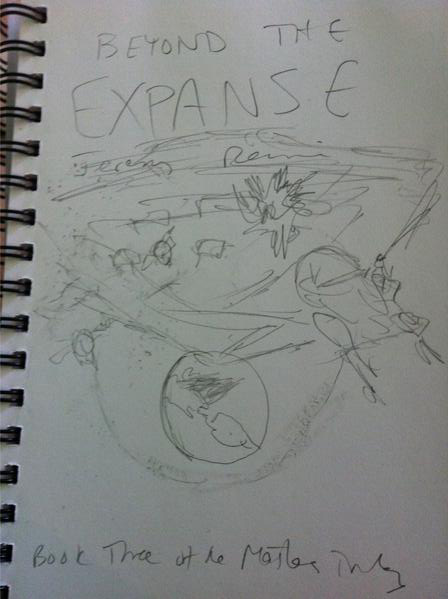
Next, I found a nice high-resolution image of Earth from NASA. Then I went into Photoshop and set the background color and placed the Earth where I wanted with the title text. For the other two novels I had a nebula for the background. For the Earth there’s obviously no nebula, but I deliberately made the background completely black, with no stars visible.
This is technically accurate (even as far away as the Moon, you don’t see stars because the light from the Earth drowns them out) but there’s a thematic reason also: this is the final novel, the ultimate showdown, and a black background is more stark and dramatic.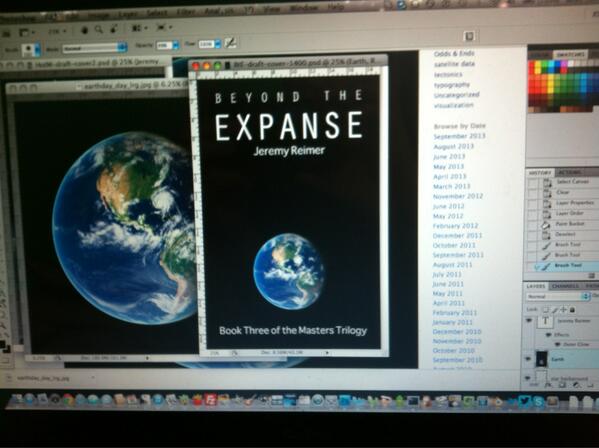
Now, I need a Master worldship! I’ve never drawn one, so it’s time to go into Blender and make one! I just start with a cube, divide it in half and mirror it, then extrude, move, scale, and rotate segments.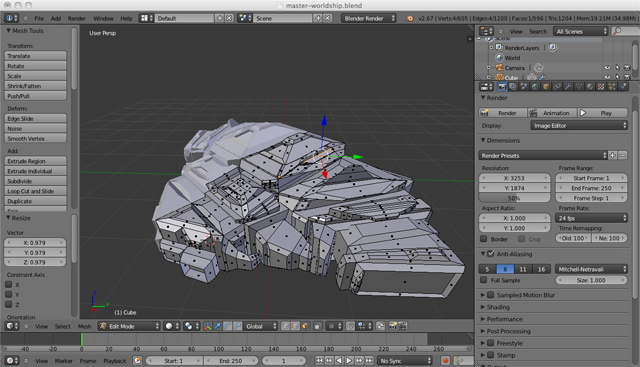
Finally I import the rendered image into Photoshop, color it yellow, and make a bubble field effect around it. I put a shadow on the Earth to give some indication of how massively huge this ship is. Then I put in an image of the Pegasus. It’s actually far in front of the worldship (or else you wouldn’t even be able to see it) but it’s difficult to indicate this. In any case, the small size of the Pegasus next to the worldship gives a sense of how one-sided this fight would be.
I’m thinking about adding more stuff to the image, such as flying fighters being chased by missiles and some explosions, but I’m not sure if it would add or detract from the final cover. I could also texture the Master worldship to make it a little more detailed, but there are diminishing returns here. What do you think?
Views: 6914
My interview with Smashwords!
Post #: 209
Post type: Blog post
Date: 2013-09-03 16:21:22.000
Author: Jeremy Reimer
Tags: Writing, Science Fiction
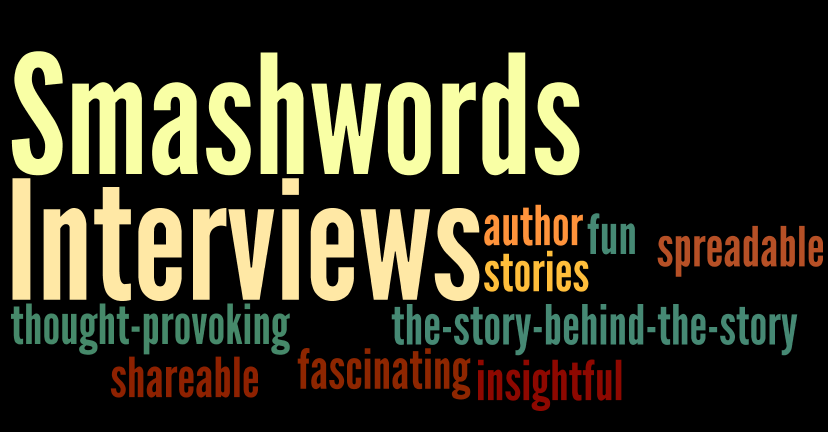
Smashwords is an amazing site, and it’s been invaluable to me in publishing and promoting my fiction. They have a new feature called Smashwords Interviews where the author can answer a series of questions and have the interview instantly appear on the site. It’s pretty cool!
I actually had more fun doing this interview than I thought I would. Rather than being a chore, it was a fun trip back into my childhood to find some of the reasons I started writing in the first place.
I hope you enjoy reading it!
https://www.smashwords.com/interview/jeremyreimer
Views: 5860
The job of a science fiction writer
Post #: 204
Post type: Blog post
Date: 2013-07-30 12:26:49.000
Author: Jeremy Reimer
Tags: Space, Science Fiction
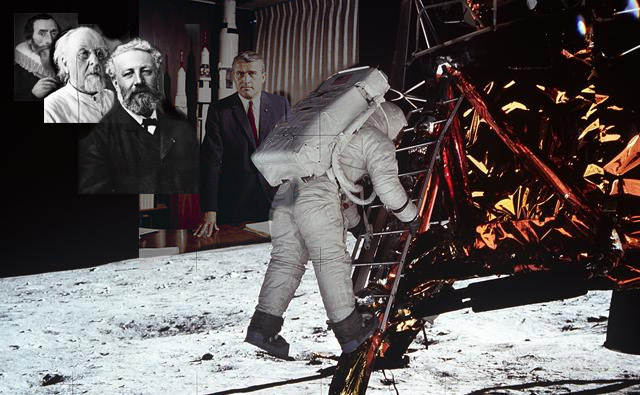
As writers, it’s our job to inspire as well as entertain. But science fiction writers have an additional duty, and it’s a monumental one.
Some of the earliest science fiction writers were scientists. Johannes Kepler, who figured out the laws of planetary motion and thus paved the way for Isaac Newton and modern physics, wrote a short story in 1630 about a trip to the moon. It was called Somnium, Latin for “The Dream”, and it featured a young student traveling to the Moon. Some consider this work the very first science fiction story, for even though it featured supernatural elements, it treated the setting with scientific vigor. The traveler was affected by gravity and observed planetary motion as understood by Copernicus. Of course, in Kepler’s time there was no conceivable scientific way of actually getting to the Moon, but it was the dream that mattered. The dream wouldn’t go away.
In 1865, Jules Verne wrote a story called From the Earth to the Moon, which took the technological advances of the recent American Civil War and applied them to peaceful pursuits. While his idea for a massive cannon to launch space travelers wasn’t actually practical (the muzzle would have to be too long and the acceleration too great for human survival) he made an attempt to do some rough physics calculations to make the story seem plausible.
In 1903, Russian scientist Konstantin Tsiolkovsky published a refutation of the physics in the popular tale, and was inspired by the story to ask the question: if cannons wouldn’t work, what would? Out of this came the theory of rocketry: Tsiolkovsky calculated a relationship between the mass of a rocket, its fuel, and its velocity. At the time no foreign scientists appreciated his work, but a German translation of his book found its way to a young engineer by the name of Wernher Von Braun, who filled it with his own notes and calculations. After Germany’s defeat in World War II, Von Braun led the American team that finally landed a man on the moon in 1969.
This is only one example of science fiction influencing reality. Young men who watched Star Trek as boys would often go on to invent some of the things they saw on the television show: talking computers, portable communication devices, and hand-held electronic displays. While it may seem as if progress in space travel has slowed since men landed on the Moon, people like Elon Musk—who wrote science fiction-themed computer games as a kid—are now developing the beginning of commercial space travel with SpaceX. There is a direct line between imagining something is possible and making it possible.
You can’t go to space without the appropriate technology, but you don’t get the idea for the technology without science fiction. Instead of predicting the future, the goal for science fiction writers should be to invent it. How else are we going to get there?
Views: 7008
So who am I?
I'm a writer and programmer. I write science fiction stories and novels.
I am the writer for the upcoming documentary series Arcade Dreams.
I also write technology articles for Ars Technica.
I'm the creator of newLISP on Rockets, a web development framework and blog application.
- Email: jeremy.reimer@gmail.com
Topics
3D Modeling
About Me
Amiga
Articles
Audio
Blockchain
Blog
Blogs
Book Reviews
Book review
Comics
Computers
Computers Microhistory
Computing
Conventions
Crypto
Daily update
Entrepreneur
Family
Forum post
Gaming
Gaming Starcraft
Gaming metaverse
Internet
Jeremy Birthday
Kickstarter
Knotty Geeks
Knotty Geeks (video)
Market Share
Masters Trilogy
Monarch
Movies
My Non-Fiction
My Science Fiction
NewLISP Blog
Novels
OSY
Operating Systems
Pets
Poll
Reviews
Science Fiction
Servers
Software
Software Operating Systems
Space
Star Gamer
Star Trek
Starcraft
Television
Testing
Toys Childhood
Wedding Marriage
Work
Work Life
World
Writing
 RSS Feed for this blog
RSS Feed for this blog